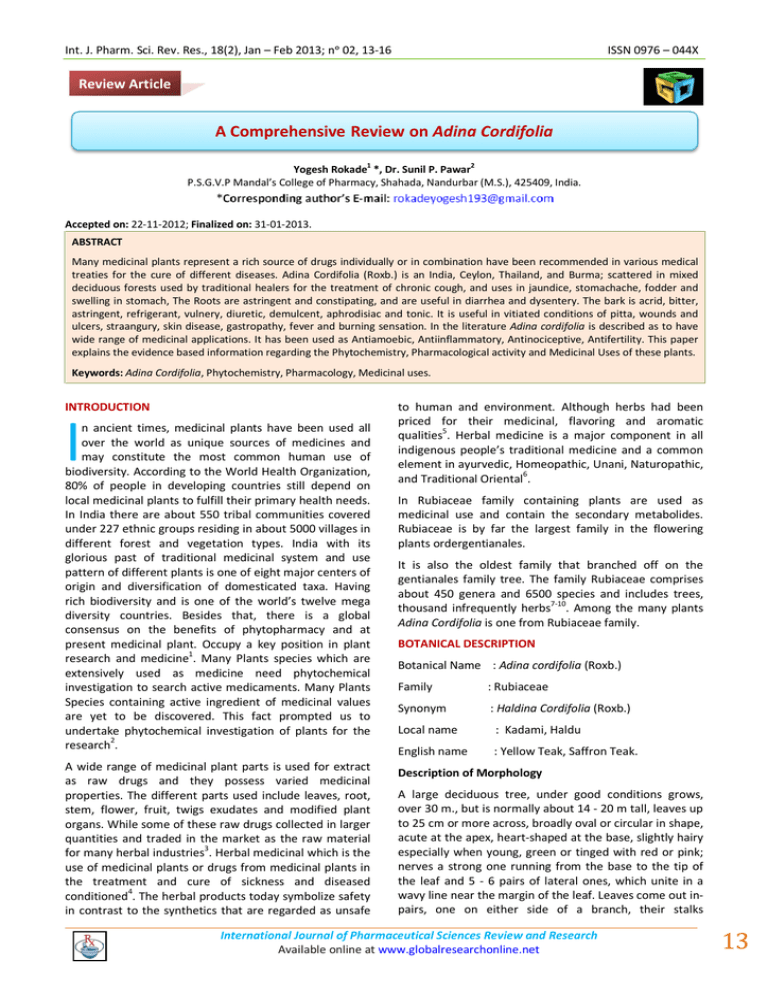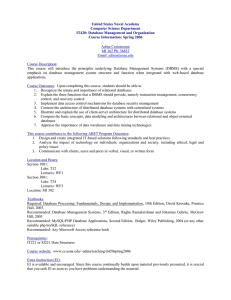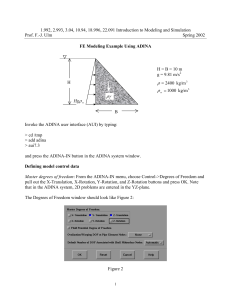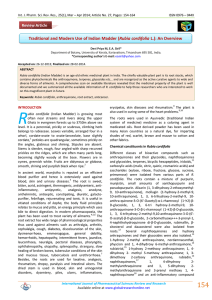Document 13308977
advertisement

Int. J. Pharm. Sci. Rev. Res., 18(2), Jan – Feb 2013; nᵒ 02, 13-16 ISSN 0976 – 044X Review Article A Comprehensive Review on Adina Cordifolia 1 2 Yogesh Rokade *, Dr. Sunil P. Pawar P.S.G.V.P Mandal’s College of Pharmacy, Shahada, Nandurbar (M.S.), 425409, India. Accepted on: 22-11-2012; Finalized on: 31-01-2013. ABSTRACT Many medicinal plants represent a rich source of drugs individually or in combination have been recommended in various medical treaties for the cure of different diseases. Adina Cordifolia (Roxb.) is an India, Ceylon, Thailand, and Burma; scattered in mixed deciduous forests used by traditional healers for the treatment of chronic cough, and uses in jaundice, stomachache, fodder and swelling in stomach, The Roots are astringent and constipating, and are useful in diarrhea and dysentery. The bark is acrid, bitter, astringent, refrigerant, vulnery, diuretic, demulcent, aphrodisiac and tonic. It is useful in vitiated conditions of pitta, wounds and ulcers, straangury, skin disease, gastropathy, fever and burning sensation. In the literature Adina cordifolia is described as to have wide range of medicinal applications. It has been used as Antiamoebic, Antiinflammatory, Antinociceptive, Antifertility. This paper explains the evidence based information regarding the Phytochemistry, Pharmacological activity and Medicinal Uses of these plants. Keywords: Adina Cordifolia, Phytochemistry, Pharmacology, Medicinal uses. INTRODUCTION I n ancient times, medicinal plants have been used all over the world as unique sources of medicines and may constitute the most common human use of biodiversity. According to the World Health Organization, 80% of people in developing countries still depend on local medicinal plants to fulfill their primary health needs. In India there are about 550 tribal communities covered under 227 ethnic groups residing in about 5000 villages in different forest and vegetation types. India with its glorious past of traditional medicinal system and use pattern of different plants is one of eight major centers of origin and diversification of domesticated taxa. Having rich biodiversity and is one of the world’s twelve mega diversity countries. Besides that, there is a global consensus on the benefits of phytopharmacy and at present medicinal plant. Occupy a key position in plant 1 research and medicine . Many Plants species which are extensively used as medicine need phytochemical investigation to search active medicaments. Many Plants Species containing active ingredient of medicinal values are yet to be discovered. This fact prompted us to undertake phytochemical investigation of plants for the research2. A wide range of medicinal plant parts is used for extract as raw drugs and they possess varied medicinal properties. The different parts used include leaves, root, stem, flower, fruit, twigs exudates and modified plant organs. While some of these raw drugs collected in larger quantities and traded in the market as the raw material 3 for many herbal industries . Herbal medicinal which is the use of medicinal plants or drugs from medicinal plants in the treatment and cure of sickness and diseased conditioned4. The herbal products today symbolize safety in contrast to the synthetics that are regarded as unsafe to human and environment. Although herbs had been priced for their medicinal, flavoring and aromatic qualities5. Herbal medicine is a major component in all indigenous people’s traditional medicine and a common element in ayurvedic, Homeopathic, Unani, Naturopathic, and Traditional Oriental6. In Rubiaceae family containing plants are used as medicinal use and contain the secondary metabolides. Rubiaceae is by far the largest family in the flowering plants ordergentianales. It is also the oldest family that branched off on the gentianales family tree. The family Rubiaceae comprises about 450 genera and 6500 species and includes trees, thousand infrequently herbs7-10. Among the many plants Adina Cordifolia is one from Rubiaceae family. BOTANICAL DESCRIPTION Botanical Name : Adina cordifolia (Roxb.) Family : Rubiaceae Synonym : Haldina Cordifolia (Roxb.) Local name : Kadami, Haldu English name : Yellow Teak, Saffron Teak. Description of Morphology A large deciduous tree, under good conditions grows, over 30 m., but is normally about 14 - 20 m tall, leaves up to 25 cm or more across, broadly oval or circular in shape, acute at the apex, heart-shaped at the base, slightly hairy especially when young, green or tinged with red or pink; nerves a strong one running from the base to the tip of the leaf and 5 - 6 pairs of lateral ones, which unite in a wavy line near the margin of the leaf. Leaves come out inpairs, one on either side of a branch, their stalks International Journal of Pharmaceutical Sciences Review and Research Available online at www.globalresearchonline.net 13 Int. J. Pharm. Sci. Rev. Res., 18(2), Jan – Feb 2013; nᵒ 02, 13-16 connected by a pair of stipules. These are two leaf-like structures, up to 2.5 cm. long, enclosing and protecting the very young leaves and shoot apex; when the stipules fall away, they leave two clear lines, each encircling half of the branch. Leaf stalks are 5-10 cm, long. Flowers are insignificant individually, being very small; but they come out in balls 2—3 cm. across; the tiny flowers are yellow or yellowish in color, often tinged with pink. When the little flowers open out, the most prominent parts are the styles, which form a sort of halo round the floral ball. Fruits are minute, forming an almost solid ball, which when ripe is black or nearly black. Leaves are shed about February, and the tree remains leafless until about May— June; the stipules covering the buds are than very conspicuous. Flower balls are at their best from June to August. After the fruit proper has been shed at about the beginning of June of the following year, the fruit-heads appear black and are about 12 mm. across: the rains of the monsoon may bring them down and prepare the tree for the new flower balls11,12. PHYTOCHEMICAL AND PHARMACOLOGICAL OVERVIEW The chemical constituents of Oleoresin, essential oil, cellulose, β sitosterol in Adina Cordifolia Root and Bark13. The shade dried bark powder of Adina cordifolia was extracted with ethanol and ethanolic extract was fractionated with different solvents. All the fractions of ethanol extract were screened for their hepatoprotective effect against CCl4 induced hepatotoxicity in wistar albino rats. The degree of hepatoprotectivity was measured by using biochemical parameters like serum transaminases (SGOT and SGPT), alkaline phosphates, total protein and total bilirubin in the treated groups, and morphological parameters as change in liver weight and liver volume. The ethanol extract and butanol fraction shows significant hepatoprotective activity as comparable with against CCl4 induced hepatotoxicity as evident by restoration of serum transaminases, alkaline phosphates, total protein and total bilirubin. Histopathology of the liver tissue further supports the biochemical finding confirming the hepatoprotective potential of these two fractions. The present study shows that ethanol extract and butanol fraction of Adina cordifolia is significantly capable of restoring integrity of hepatocytes indicated by improvement in physiological parameter of hepatocytes. Phytochemical screening of ethanolic extract and its four fractions reveals the presence of Alkaloids, flavonoids, saponins, terpenes, tannins, Carbohydrates14. The acetone (AEAC) and aqueous extracts (AQEAC) of Adina cordifolia, belonging to the family Rubiaceae, were studied for hepatoprotective activity against Wister rats 15 with liver damage induced by ethanol . Studied on Active principle from root bark of Adina cordifolia was extracted in benzene and ethyl acetate and was seen to exhibit antiamoebic activity with IC50 values of 2.92 and 16 2.50µg/ml, respectively . Studied extractives of some forest produce including acetone and alcohol extracts of bark and roots of Dalbergia stipulacea, leaves of Eucalyptus hybrid and Adina cordifolia, ursolic acid and 14 ISSN 0976 – 044X bryonolic acid were evaluated as insect antifeedant against poplar defoliator Clostera cupreata (Lepidoptera : Notodontidae). Ursolic acid (separated from Eucalyptus hybrid leaves extract) has shown maximum antifeedant activity and gave over 92 per cent protection of poplar leaves from its pest. It was followed by alcohol and acetone extracts of Eucalyptus hybrid leaves, bryonolic acid, acetone extract of D. stipulacea bark, alcohol extract of A. cordifolia leaves8. Studied on the plants like Adina cordifolia, Asparagus racemosus, Aegle marmelos, Cassia Tora, Dillenia pentagyna, Valeriana wallichii showed little activity (5 to 8mm) against some pathogenic 17 microorganisms . Isolation of 7-hydroxycoumarin and 7beta-D-glucosy lcoumarin, respectively. Umbelliferone was converted into 7-acetoxycoumarin, which on treatment with aluminum chloride afforded 7-hydroxy-8acetylcoumarin. A new series of thiosemicarbazones of 7hydroxy-8-acetylcoumarin with different thiosemicarbazides were synthesized. Umbelliferone was also converted into its methoxy derivative (7methoxycoumarin). Subsequently all the compound 18 assessed antiamoebic activity . Studied on Evaluation of Anti-inflammatory potential of Adina Cordifolia bark19. Carried studies Petroleum ether and ethyl acetate extracts of Adina Cordifolia bark were screened for antiinflammatory and analgesic activity20. Studied on extract of Adina Cordifolia leaves and Bark using the solvent Dichloromethane and methanol shows the activity against micro-organism21. A new Indole alkaloid from the heartwood of Adina Cordifolia22. Haldinia cordifolia stem had been evaluated for its antiulcer potential. Enzyme assay-guided fractionation of the chloroform extract yielded 7-hydroxycoumarin as the active constituent which showed interesting HqrKq ATPase inhibitory activity23. Studied on Preliminary pharmacology of acetone extract fraction of wood of Adina cordifolia24. Four compounds isolated from the stem of Adina cordifolia were identified as stigmasta-5, 22 – diene -3β– O-rhamnopyranosyl-(1D-xylopyranoside, α-amyrin, octacosanol, and naringenin-7-methyIether-4′- α - L4 ) – β O-α-L-rhamnopyranoside on the basis of spectral and 25 chemical evidence . Studied on Four compounds isolated from the stem of Adina cordifolia were identified as stigmasta-5,22-diene-3P-O-a-rhamnopyranosyl-(1-4)-P-Dxylopyranoside, a-amyrin, o-ctacosanol, and naringenin – 7 – methyl ether - 4' – O – a –rhamnopyranosoinde the basis of spectral and chemical evidence26,27. MEDICINAL USES KNOWN SO FOR Fresh bark is ground with brown sugar and taken 28 internally for stomachache . Bark and leaves are used for cholera, cold cough, fever, headache, Scars and skin 29 yellowish of body, urine complaints . Laves are used on 30 cough and cold . Fresh stem bark juice is taken in 31 32 rheumatism . Latex is applied on aching tooth . Stem 33 bark used on fever . Leaves are applied over swollen 34 portion to remove pain and swelling . Bark is used as a antibacterial, eczema, Scabies, Bark paste is applied to eczema, Scabies, or bacterial infections on the skin35. Bark International Journal of Pharmaceutical Sciences Review and Research Available online at www.globalresearchonline.net a Int. J. Pharm. Sci. Rev. Res., 18(2), Jan – Feb 2013; nᵒ 02, 13-16 36 used on the urinary problem . Leaf juice is used to treat boils and eye disorders like conjunctivitis37. Bark is used on burning sensation of urine38. Stem bark powder is used 39 to prevent miscarriages . Stem bark is crushed, warmed and applied in the region of abdomen and loin against bodyache40. Paste stem bark and leaves are used in deep wounds, Jaundice, Stomachache, and swelling in stomach41. Decoction of stem bark is used in the morning for 4-5 days42. Adina cordifolia are gives activity of 43 Antibacterial, antiseptic, antibilious, febrifuge . CONCLUSION The present work was carried out on plant Adina Cordifolia family: Rubiaceae here more emphasis was given on literature reviews of phytochemical & Pharmacological reviews on Adina Cordifolia Plants. After thorough investigation and literature search it was observed that less work has been done on this plant especially on its leaves. In traditionally the plant Adina cordifolia has a large demand due to its treatment of many chronic and acute diseases with great benefits. This study attempts to high lighten the Therapeutic potential of Adina Cordifolia and their constituents in the prevention or therapy of disease. From this study we Can conclude that the results reviewed in the study are aimed at attracting the attention of researchers seeking new drugs from Adina cordifolia and its chemical compounds. The isolated compounds can hopefully be considered in future for more clinical evaluations and possible applications and as adjuvant to current medications. We should maintain our efforts in considering and valorizing our natural patrimony as well as conducting more research in Adina Cordifolia and its Pharmacological aspects. REFERENCES 1. 2. 3. 4. 5. 6. Ribeiro A, Maria R, Joao T, Maria F, Ethnobotanical survey in Canhane village, district of Massingir, Mozambique: medicinal plants and traditional knowledge, Journal of Ethnobiology and Ethnomedicine. 6(33), 2010, 3-15. Rajput AP and Yadav SS, Medico-Botanical and Phytochemical Studies on Medicinal Plants of Dhule and Nandurbar Districts of Maharashtra State, Journal of Physiological. Research, 13(2), 2000, 161-166. Periyasmy A, Kamizozhi M, Phytochemical screening and antimicrobial activity from five Indian Medicinal Plants against Human pathogens, Middle-East Journal of Scientific Research., 5(3), 2010, 157-162 . Ogunkunle ATJ, Ladejobi TA, Ethanobotnical and phytochemical studies on some species of Senna in Nigerian, African Journal of Biotechnology, 5(21), 2006, 2020-2023. Jain A, Choubey S, Singour P, Rajak H, and Pawar R, Sida cordifolia (Linn) – An overview, Journal of Applied Pharmaceutical Science 1 (2), 2011, 23-31. Kokate CK, Purohit A P, Gokhale SB, Pharmacognosy, Nirali Prakashan, Third-fourth edition,2006,1-7. ISSN 0976 – 044X 7. Narayanan A, Mithunlal S, Sujanapal P, Kumar Anil, Sivadasan M, Ahmed H and Altar A, Ethnobotanically Important Trees and their uses by Kattunaikka tribe in Wayanad Wildlife Sanctuary, Kerala, India, Journal of Medicinal Plants Researc, 5, 2011, 604-612. 8. Ahmad R, Mahbob M, Noor ZM, Ismail H, and Shaari K, Evaluation of antioxidant potential of medicinal plants from Malaysian Rubiaceae, African Journal of Biotechnology, 9(46), 2010, 7948-7954 . 9. Nayak S, Mengi S, Prelimnary Physicochemical and Phytochemical Evaluation of Morinda Citrifolia Fruit Extractives, International Journal of Pharmacy and Pharmaceutical Science.2(4),2010,150-154. 10. Kananan M, Ranjit AJA, Narayanan M, Phytochemistry and Ethanopharmacological studies on Rubia Cordifolia, Ethnobotanical Leaflets,13,2009,338-342. 11. Roy GP, Bhaskar BK, Flora of Madhya Pradesh, Ashish Publication House, 1992, 212. 12. Cooke T, The Flora of the Presidency of Bombay, Authority of the secretary of state for India in council,1901,580-581. 13. Bharti DT, Raghunath TM, Manojkumar ZC and Namrata VN, Nephro protective plants: A Review, International Journal of Pharmacy and Pharmaceutical Science, 4, 2012, 8-16. 14. Rakesh S A, Photochemical Investigation and Screening of Hepatoprotective activity of “Adina cordifolia (Roxb.) Hook” bark, Continental Journal Pharmacology and Toxicology Research, 5,2012,10. 15. Sharma A, Sangameswarm B, Jain V, Saluja MS, Hepatoprotective activity of Adina Cordifolia against ethanol induce hepatotoxicity in rats, International Current Pharmaceutical Journal, 9, 2012, 279-284. 16. Dolly R, Plant Extract with Antiamobic properties: A Theoretical study with reference to Enthamoeba histolytica. International journal of Pharma Tech. Research, 3, 2011, 1113-1117. 17. Maji S, Dandapat P, Ojha D, Maity C, Halder SK, Das M, Pathak TK, Patil BR, Samanta A and Mondal KC, In Vitro Antimicrobial Potentialities of Different Solvent Extracts of Ethnomedicinal Plants Against Clinically Isolated Human Pathogens, Journal of Phytology, 2(4),2010, 57–64. 18. Iqbal PF, Bhat AR, Azam A, Antiamoebic coumarins from the root bark of Adina cordifolia and their new thiosemicarbazone derivatives, European Journal of Medicinal Chemistry, 44 (5),2009,2252-2259. 19. Kausik V, Khosa L, Parcha V, Evaluation of AntiInflammatory Potential of Haldina cordifolia bark Extracts, International journal Pharmbit, 2, 2009,126-130. 20. Jain AP, Pawar RS, Singhai A, Anti-inflammatory and Antinociceptive Activity of Adina Cordifolia Bark, Antiinflammatory and Anti-nociceptive Activity of Adina Cordifolia Bark, Nigerian Journal Natural Product and Medicine, 10, 2006, 90-93. 21. Jaysinghe ULB, Jaysooriya CP, Bhadra, Ekanayak SP, Merinil, Assante G, Antimicrobial activity of some Srilankan Rubiaceae and Meliaceae, Fitoterapia, 73,2002,424-427. International Journal of Pharmaceutical Sciences Review and Research Available online at www.globalresearchonline.net 15 Int. J. Pharm. Sci. Rev. Res., 18(2), Jan – Feb 2013; nᵒ 02, 13-16 ISSN 0976 – 044X 22. Balazs B, Tóth G, Rao PS, Narender T, Rao NS, Horvath G and Duddeck H, A New Indole Alkaloid from the Heartwood of Adina Cordifolia, Magnetic Resonance Chemistry, 37,1999,751-753 . 34. Singh PK, Kumar V, Tiwari RK, Sharma A, Rao V, Singh RH, Medico-Ethnobotany of ‘Chatara’ Block of District Sonebhadra, Uttar Pradesh, India, Advances in Biological Research. 4 (1), 2010, 65-80. 23. Kasinadhuni VRR, Rajashekhar G, Rajagopalan R, Sharma VM, Vamsi KC, Sairam P, Sai P, Sadhukhan S, Gangadhar R, Anti-ulcer potential of Haldinia cordifolia, Fitoterapia. 70, 1999, 93-95. 35. Hossan S, Hanif A, Khan M, Bari S, Jahan R, Rahmatullah M, Ethnobotanical survey of the Tripura tribe of Bangladesh., American-Euras Journal of Sustainable Agriculture, 3(2), 2009, 253-261. 24. Visweswaram D, Seetharamaiah D, and Rao S, Preliminary pharmacology of acetone extract fraction of wood of Adina Cordifolia. Indian Journal of Pharmacy, 35(6), 1993, 203. 36. Mishra D, Broker A, An Ethnomedicinal Study among the Gond of Chhattisgarh: India, Antrocom, 5(1), 2009, 61-65. 25. Santosh KS, Constituents from Adina cordifolia, Canadian Journal of Chemistry, 61(8),1983,1827-1830. 26. Shrivastva SK, Constituents of Adina Cordifolia, Canadian Journal of Chemistry, 61, 1981, 1827-1830. 27. Jack R, Emil L, Vitcha L, Isolation of Cadambine From Adina Cordifolia Beanth and Hook, Science Asia, 6, 1980, 54-58. 28. Bhasker A, Samant L, Traditional Medication of Pachamalai Hills, Tamilnadu, India Global Journal of Pharmacology, 6, 2012, 47-51. 37. Rahmatullah M, Hossan S, Hanif A, Roy P, Rownak J, Khan M, Majeedul H, Chowdhury R, Ethnomedicinal Applications of Plants by the Traditional Healers of the Marma Tribe of Naikhongchhari, Bandarban District, Bangladesh, Advances in Natural and Applied Sciences, 3(3), 2009, 392-401. 38. Shukla R, Chakravarty M and Gautam MP, Indigenous medicine used for treatment of gynecological disorders by tribal of chhattisgarh, India, Journal of Medicinal Plants Research, 2, 2008, 356-360. 39. Jadhav, Ethanomedicinal Plants used by bhil tribe of biodiversity, Madhya Pradesh, Indian Journal of traditional Knowledge.5(2),2006,263-267. 29. Singh A and Dubey N, An ethnobotanical study of medicinal plants in Sonebhadra District of Uttar, Pradesh, India with reference to their infection by foliar fungi: Journal of Medicinal Plants Research, 6,2012,2727-2746. 40. Patil MV, Patil DA, Ethanomedicinal Practices of Nasik District. Maharashtra, Indian Journal of Traditional Knowledge, 4(3), 2005, 287-290. 30. Pawar S and Patil DA, Ethnomedicinal plants in jalgaon district, Current Status, 2, 2011, 15-21. 41. Jain A, Katewa SS, Galav PK, Sharma P, Medicinal plant diversity of Sitamata wild life sanctuary, Rajasthan, India, Journal of Ethnopharmacology. 102, 2005, 143–157. 31. Jain SP, Singh SC, Srivasatava S, Singh J, Mishra NR, Prakash A, Hitherto Unreported Ethanimedicinal Uses of Plants of Betul District of Madhya Pradesh, Indian Journal of Traditional knowledge, 9(3),2010,522-525. 32. Kambale SY, Patil SR, Sawant S, Pawar SG, Singh EA, Studies of Plants used in Traditional Medicinal by Bhilla Tribe of Maharashtra, Indian Journal of Traditional Knowledge. 9(3),2010,591-598. 42. Chetri D R, Medicinal Plants used as Antipyretic agent by the Traditional Healers of Darjeeling Himalayas, Indian Journal of Traditional Knowledge. 3(3), 2004, 271275. 43. Khare CP, Indian medicinal plants, Springer science business media LLC.2007, 20-21. 33. Padal SB, Murty P, Rao S and Venkaiah M, Ethnomedicinal Plants From Paderu Division of Visakhapatnam District, A.P. India, Journal of Phytology, 2(8), 2010, 70-91. Source of Support: Nil, Conflict of Interest: None. 16 International Journal of Pharmaceutical Sciences Review and Research Available online at www.globalresearchonline.net a





